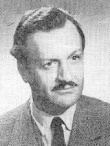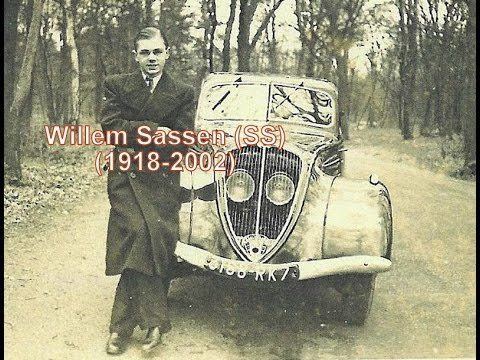Name Willem Sassen Role Journalist | Died 2001, Chile Children Saskia Sassen | |
 | ||
Spouse Els Delbaere (m. 1970), Paula Fisette (m. 1940), Miep van der Voort People also search for Saskia Sassen, Miep van der Voort, Richard Sennett | ||
Uki go i adolf eichmann willem sassen
Wilhelmus Antonius Sassen (born 16 April 1918 – died 2002) was a Dutch collaborator, Nazi journalist and a member of the Waffen-SS, where he had the rank of Untersturmführer corresponding to 2nd Lieutenant. He became widely known around 1960 as the interviewer of Adolf Eichmann.
Contents
- Uki go i adolf eichmann willem sassen
- Private biography family
- Nazi and SS career up to 1945
- Escape to and second career in Argentina
- The Eichmann interviews
- References

Private biography, family

Willem Sassen was born in Geertruidenberg, Netherlands. He grew up in a traditional Roman Catholic family in North Brabant and attended a gymnasium in Neerbosch near Nijmegen and in Breda. His father was impressed by the fascist ideas of the Zwart Front (literally 'Black Front'). Sassen decided not to become a priest but to study law in Leuven and Gent instead. As a student, Sassen became a member of the German-Flemish workers' group DeVlag. When Sassen visited the 1936 Summer Olympics in Berlin, his admiration for Hitler and Nazi Germany grew. Because of Sassen's pro-Nazi political activities, the authorities expelled him from Belgium, so he could not finish his law studies.
In 1938 Sassen became a recruit in the Dutch army and was trained as an artillerist. When Nazi Germany invaded the Netherlands on 10 May 1940, Sassen was a member of the 7th Field Artillery regiment and was taken prisoner by the Germans for a short time.
Sassen married Paula Fisette in 1940, divorced, and later married Miep van der Voort, with whom he had two daughters. Their eldest daughter is Saskia Sassen (born 1947 in The Hague), the internationally known American sociologist and professor of economics. Sassen's third wife was Els Delbaere, the daughter of a Flemish artist who, because of his own Nazi past, had also fled to Argentina.
Nazi and SS career up to 1945
On 22 June 1941, Nazi Germany invaded the Soviet Union (Operation Barbarossa), and Sassen volunteered for the German Eastern front. He became a member of the first Netherlands PK ("Propaganda Kompanie"). Because he had been working for Radio Bremen for some time already, he could start his work as a war correspondent after a short cut training. He was a "Wort-und Funkberichter" with the SS-division "Wiking" in the southern sector of the front and in the spring of 1942 witnessed the offensive in the Caucasus. On 26 July 1942, Sassen was wounded near Rostov and during the following eight months recovered in hospitals in Kraków, Munich and Berlin. In April 1943 he was promoted to SS-Unterscharführer (the lowest rank of non-commissioned officer, comparable to a US Corporal) and assigned to an SS armoured division near Kharkov. In the summer of 1943, he followed another training course on war correspondence and propaganda together with Dutch colleagues in Villach, Austria.
From August 1943 to June 1944, together with his Flemish colleague Jef Desseyn, Sassen formed the permanent editor team of Radio Brussels (Zender Brussel). The team was also responsible for training courses for war correspondents. On 6 June 1944 (D-Day), Kriegsberichter Sassen was at the front in Normandy reporting the battles around Caen, Bayeux, Saint-Lô, Avranches, Falaise and Lisieux. On 1 September 1944, Zender Brussel was ordered to be evacuated to Germany. Sassen remained in the Netherlands, reported the airborne landings around Arnhem and became the editor of the newspaper Het Nieuws van den Dag in Amsterdam. On 23 October 1944, Sassen in his newspaper called upon the hungry and cold of Amsterdam to go robbing food and fuel in the districts of the more rich and wealthy people; this was too much even for the Germans, and on pressure of the Sicherheitsdienst police, Sassen was dismissed.
Willem Sassen was sent to Doetinchem where he was active in the black propaganda Aktifpropaganda, Skorpion West. There he published Het Laatste Nieuws. At the beginning of 1945 Sassen was asked to participate in a Werewolf organisation in case the allied forces overran the German army in the Netherlands. He became the leader of Neurop (Neu Europa). The group was to pass on military intelligence on allied troop movements and to commit sabotage.
The German army capitulated sooner than was expected, and Willem Sassen fled together with his younger brother Alfons to Alkmaar. Former members of the Dutch resistance offered them a refuge; Willem Sassen had aided certain members of the Dutch resistance during the war, including Anthony Mertens, an old prewar friend.
Escape to and second career in Argentina
On 5 June 1945, Sassen was arrested in Alkmaar by British Field Security and interned in Fort Blauwkapel near Utrecht. On the 15th of December he fled with two other inmates. He first went to his girlfriend Miep van der Voort (Utrecht) and later to his friend Anthony Mertens. For two years Sassen went into hiding in Antwerp, Brussels and Amsterdam. With the help of his friends, among whom were Mertens and former SS member Karl Breyer, Sassen managed to obtain a passport. In May 1947 he flew in a KLM plane to Dublin, Ireland. There he met up with some of his old comrades, before setting off to Argentina. Together with his girlfriend Miep van der Voort, their daughter Saskia Haremaker (The Hague 1947), and some former SS men and collaborators, he departed in the coastal vessel The Eagle under the command of former U-boot captain Schneider to Buenos Aires. On the 3rd of November they arrived at the docks of Darsena Norte in Buenos Aires. Three days later they were allowed to disembark. The Sassen family lived first in Ciudad Jardín Lomas del Palomar (Greater Buenos Aires), where their second daughter was born. Willem Sassen started to work as a journalist, translator and as a ghost writer for Hans Ulrich Rudel and later Adolf Eichmann.
Around 1960, Willem Sassen was recruited by Georg Mertins. He was asked to represent Merex AG, which was a cover for the illegal arms trade controlled by the German secret service Bundesnachrichtendienst. Other representatives in Latin America were Klaus Barbie (Bolivia), Friedrich Schwend (Peru), his brother, Alfons Sassen (Ecuador) and, in Madrid, Spain, Otto Skorzeny.
In the 1970s, Sassen among others worked as a PR-consultant for Chile's dictator Pinochet and Paraguay's dictator general Alfredo Stroessner.
The Eichmann interviews
In 1960, Sassen interviewed Adolf Eichmann about his involvement in the Nazis Final Solution. Parts of the interviews were published in two articles in Life magazine. It is assumed that the transcripts of the interviews are much more realistic and personal than the autobiography Eichmann wrote while in prison in Israel, possibly attempting to place himself in a better light and alter the outcome of the trial. In 1980 the Sassen documents or Sassen tapes, consisting of approximately 600 pages of material from the interviews, were transferred to Eichmann's widow, Veronika.
Sassen himself was interviewed in an edition of the British World in Action (Granada/ITV, 1978) about his connections in Argentina with Josef Mengele; the Auschwitz concentration camp physician was still alive and on the run at the time.
The Sassen "Interviews" are documented in detail in Eichmnann Before Jerusalem by Betttina Stangneth, Vintage Press, 2015. Sassen sold some of the material to Life Magazine.
